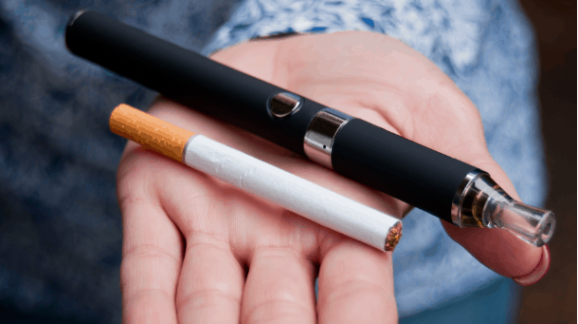FDA Can Save Lives by Rejecting Scott Gottlieb’s Lies
E-cigarettes have proven effective at helping people quit smoking, a massive potential public health gain, considering nearly half a million people die every year from smoking-related illnesses. The big question is: How can we help smokers quit and at the same time discourage young people from taking up either smoking or vaping?
Former Food and Drug Administration Commissioner Scott Gottlieb has paid some lip service to “preserv[ing] e-cigarettes as a tool to help adult smokers while snuffing out the teen smoking epidemic,” but it’s difficult to believe Gottlieb or the FDA when they’ve been lying to us so far.
Teen smoking remains a concern, but let’s be honest about the size and scope of the problem: There is no teen smoking epidemic.
Adolescent use of combustible tobacco products, like cigarettes and cigars, is at an all-time low. Perhaps Gottlieb simply “misspoke,” accidentally conflating the vaping rates with smoking. A national survey showed a significant uptick in youth use of e-cigarettes in the last year. But smoking and vaping are not the same products, nor do they pose the same health risks. Unfortunately, evidence over the last two years indicates Gottlieb and the FDA may be intentionally conflating the two, and that is dangerous.
Americans’ trust in national institutions is lower than ever. If that lack of confidence extends to health institutions, it can have deadly consequences when there are true emergencies, such as outbreaks of infectious or food-borne illnesses. The ability of agencies like FDA and the Centers for Disease Control and Prevention to protect the public from immediate threats depends on the public’s confidence in those agencies and their willingness to follow agency recommendations. The disturbing rise in infectious childhood diseases, caused by vaccine skepticism, is just one example of what happens when people lose faith in health agency wisdom.
Given the pivotal role public trust plays in protecting public health, the FDA’s attempts to mislead the public about e-cigarettes is shockingly reckless. It began when the FDA chose to lump e-cigarettes into the same legal category as all other tobacco products. While e-cigarettes do not contain tobacco, they (sometimes) contain tobacco-derived nicotine, which allowed the FDA in 2016 to wrongly classify e-cigarettes as tobacco products. Though Gottlieb has repeatedly acknowledged that not all tobacco products are equally harmful and there is a “continuum of risk,” it didn’t stop him or his agency from capitalizing on the public’s fear of smoking to provoke a panic about e-cigarettes.
The study showing e-cigarette use among adolescents rose between 2017 and 2018, the CDC’s National Youth Tobacco Survey, is a survey that only captures any use in the last 30 days. That might capture habitual users, but it also includes mere experimentation (e.g. a one-time puff off a friend’s vape at a party), not necessarily regular use. Once you exclude 18 year-old adults, students who used other tobacco products, and experimental users, the survey actually found that only 0.6% of high schoolers regularly vaped (about 95,000 kids). While that is still concerning, it is not an “epidemic.” Yet, that is how the FDA portrayed the problem to the public.
The FDA issued statements that the CDC survey found a “sharp and startling reversal of overall declines in youth tobacco use.” If you consider e-cigarettes tobacco then, this is technically true since e-cigarette use among youth was among the only types of tobacco that increased in the last year. But, the tactical phrasing of “tobacco use” made the public think that teen use of cigarettes had increased, which is not the case.
A year before the CDC released the results of its survey showing that, after two years of declines, teen vaping had increased, the FDA had already launched its “epidemic” campaign. This was a market-tested messaging initiative designed to scare the public about vaping. In particular, FDA hoped to dissuade adolescent experimentation with e-cigarettes. And, while it’s appropriate that the agency would warn teens about the risk of addiction and the possible harms associated with some of the chemicals in e-cigarettes, the claims that they may cause “irreversible lung damage” or cancer is not supported by the evidence.
The campaign also omitted that the number and amount of potentially dangerous chemicals are much lower in e-cigarettes than traditional cigarettes. Likely, the FDA was worried that such truthful information might reduce the campaign’s effectiveness in discouraging youth vaping.
Unfortunately, adults have also been absorbing the FDA’s fear-mongering against e-cigarettes. As a result, more than 40% of adults, including current smokers, now mistakenly believe that e-cigarettes are as harmful or more harmful than smoking.
This is not an unintended consequence. Gottlieb’s FDA knew their campaign messaging not only increased e-cigarette fears in teenagers but also that it led to the mistaken belief among adults that e-cigarettes are equally or more harmful than smoking.
Gottlieb’s ability to communicate truthful information to the public clearly has not improved since leaving the FDA. In addition to peddling the idea of a youth vaping epidemic, he abandoned a commitment to science-based communication by suggesting there is an adolescent smoking epidemic and that it is somehow related to e-cigarettes.
Anyone who looks at the increase in vaping and the continued declines in smoking in both adolescents and adults can see this is a preposterous suggestion. Such blatant falsehoods undermine public trust in the FDA. Unless the new commissioner establishes a commitment to providing accurate, unbiased guidance so consumers can make their own informed choices, the public may stop listening to the FDA when it counts.
Unfortunately, it won’t be the FDA or Scott Gottlieb that pays the price: It will be the public, and we might pay with our lives.
Originally published at the Washington Examiner.
